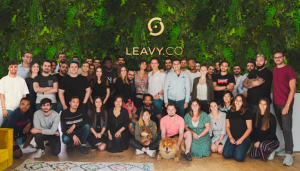Without YouTube, late night TV barely exists. That’s not because Lilly Singh, a YouTuber with nearly 15 million subscribers, made television history in September by taking over Carson Daly’s slot on NBC. No, not really. A Little Late with Lilly Singh is just the latest installment in a trend that began 10 years ago, when Jimmy Fallon, then helming Late Night with Jimmy Fallon and getting only middling reviews, went viral after inviting Justin Timberlake to help him rhyme his way through the history of rap. The “History of Rap” video got twice as many views online as it did on air, an upset that would soon become the norm.
In the years since, Fallon (and compatriots like Jimmy Kimmel, Stephen Colbert, Seth Meyers, John Oliver, James Corden, and Samantha Bee) have engineered their shows to be consumable as YouTube clips. They’ve altered the late-night format to resonate with whatever trends and #Challenges are sweeping across the platform. Popular YouTubers have become regular entrants to the show’s guest rotations. It’s not so much that YouTube has gone mainstream as the mainstream has gone YouTube.
Taking over TV is quite the coup for a platform that got its start just 15 years ago above a pizzeria in San Mateo, California, and it’s not just late-night television that’s ceding territory to the big red play button. Just about all video media consumed around the world, whether it’s a highbrow movie or a comedy variety show, has to acknowledge and interact with YouTube somehow—in its marketing, in its release, in its post-theater sale strategy. YouTube has become the world’s largest video hosting website, and one of the internet’s most popular search engines, second only to its parent company, Google. Woe betide the crusty CEO who sees it only as a cat video repository.
Of course, the cat video did have its heyday. When YouTube first became popular between 2005 and 2007, it was for short videos, not much more than three minutes. (Yes, many of them were goofy: cats, women wiping out while stomping wine grapes, and ohmygod shoes.) That wouldn’t seem to pose much of a temptation for (or threat to) mainstream television, but the overlap began almost immediately. SNL Digital Shorts (remember “Dick in a Box” and Natalie Portman rapping about what a badass she is?) were early TV-to-YouTube successes. In 2007, CNN and YouTube aired the presidential debates. A year later, YouTube had penned agreements with MGM, Lionsgate, and CBS to stream full-length movies and television shows on the platform. These days, you can buy almost any movie or TV show you’d wish for on YouTube, and they’ve even tried their hand at making a few of their own shows with boldface names like Jordan Peele.
YouTube the company isn’t really the driving force behind these changes in the trends and norms of television, though. It’s YouTubers themselves, the independent creators responsible for the majority of the nearly 5 billion videos watched on the platform daily. For younger generations like millennials, Gen Z, and Gen Alpha, YouTubers are as culturally significant as any traditional pop or movie star, if not more so. In the beginning, they were Anybodies— people with webcams, charisma, and a fair amount of luck—and to a certain extent that’s still true. YouTubers are able to attract followings in the first place because they offer something of value to a specific community that at least seems to be “authentically” theirs. Often, it’s subject area expertise born of years-long personal interest, like makeup or humor or history or bicycles. Over time, though, the most successful YouTubers are the ones who have been able to parlay the popularity they gained from sharing their original interest (say, videogames for PewDiePie or nail art for Simply Nailogical or pranks for the Paul brothers) into a more generalized form of celebrity. When enough people have come to care about you as a person, they’ll evidently watch you do just about anything.
Therein lies the magic, and the danger. As YouTubers became stars, more and more companies wanted to work with them. They started routinely appearing in advertisements for brands as big as Taco Bell. Companies paid YouTubers to use and feature their products (which is called a sponsorship) and paid YouTube to run their advertisements before, after, and amidst YouTubers’ videos. At this point, YouTube likely generates somewhere between $16 and $25 billion in revenue per year. That’s high stakes for everyone, but particularly for advertisers who are fronting the bulk of that money and staking a portion of their reputation on the YouTubers they’re associating with.
So, beginning around 2017, when high profile YouTubers like PewDiePie and Logan Paul started using their platforms to behave in reprensible ways, YouTube drew criticism from the public and the media, and advertisers threatened to take that money away. YouTube responded: They slashed who was eligible to make advertisement money, subjected videos to more rigorous levels of screening, and tweaked their algorithms to prioritize content deemed “advertiser safe” over others.
The result? Increased professionalization, and an increasing resemblance to conventional television. To thrive on YouTube now, it pays to be squeaky clean enough for Johnson & Johnson or Nike, and successful enough to pay a manager and an agent to negotiate your deals and smooth over any mistakes you do make. (It’s a bit of an ouroboros of privilege: Success gets you the resources to be “advertiser friendly,” and being advertiser friendly pays enough to cover those resources.) YouTube has made it clear that they like to work with existing brands that they feel they can trust, like our colleagues at Bon Appetit—some of whom have become so prominent on YouTube that they became Halloween costumes. Big names like Bon Appetit or BuzzFeed have developed suites of successful YouTube series, functioning a great deal like television studios, but with reliable audiences in the millions. As YouTube’s relationship with advertisers has stabilized, they’ve pushed creators to make longer and longer videos so they can run more interstitial advertisements. If the average length of a YouTube video was around three minutes 10 years ago, these days it’s closer to half an hour.
In other words, TV show length. There are real reasons to be suspicious of the new, glossier, advertiser-oriented YouTube, which the people behind the effort to unionize YouTubers communicate eloquently: It creates a culture of corporate-friendly sameness, and income insecurity for anyone who doesn’t toe the new line.
There’s also a lot to celebrate about how far YouTube has come in the last decade, and what it’s done with the influence it has. It’s given enormous voices to people who haven’t had access to or acceptance in conventional broadcasting, like the LGBTQ+ community. It’s allowed people’s culture consumption habits to become global, borderless. And it’s wildly popular. Not only has YouTube influenced television by shaping its content, its hosts, and its marketing strategies, but it has, for some people, almost come to replace it.
More Great WIRED Stories
- Where the 5G data storm will hit first
- How we learned to love the pedagogical vapor of STEM
- What a 5,700-year-old piece of gum reveals about its chewer
- Meet the activists risking prison to film VR in factory farms
- Jot down your thoughts with these great note-taking apps
- 👁 Will AI as a field “hit the wall” soon? Plus, the latest news on artificial intelligence
- 💻 Upgrade your work game with our Gear team’s favorite laptops, keyboards, typing alternatives, and noise-canceling headphones



